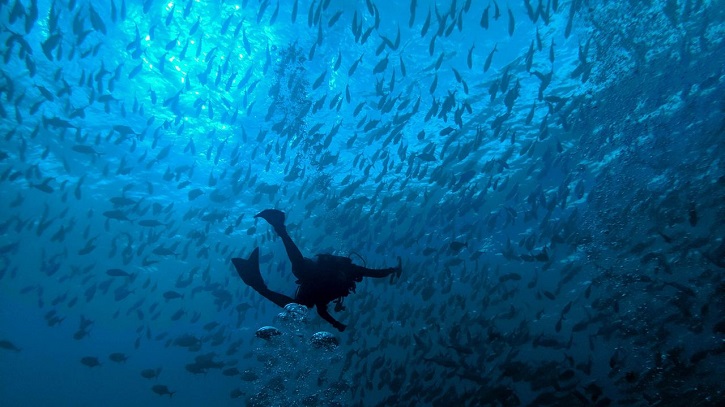
The full Moon is a mating call for one of the ocean's most extraordinary phenomena, when thousands of red snapper gather in what can only be described as a frenzied fish orgy.
At 06:00, our small boat was floating a few miles from shore in the island nation of Palau, the early morning sun occasionally reflecting off the gentle curve of the waves. Eight divers were perched on the side of the boat, backs out, wetsuits on, scuba diving air valves fully open. But we were in a holding pattern, heads bobbing from both surface swells and lingering fatigue. Though ours were drooping, our captain's eyes were fixed on the point where our scuba diving guide had submerged minutes prior. The objective: locating Lutjanus bohar, commonly known as red snapper.
But one fish wouldn't do — we were looking for at least 1,000. Five thousand would be better.
Suddenly, our guide's hand shot skyward, indicating he'd spotted what had brought us to this place at this time: an amorphous, ephemeral mass of snapper that regularly spawn at this particular dive site, called Shark City.
A quick reverse count from three, and we backrolled into the water as one unit, quickly descending to 31m below the surface. The depth put us eye to bulging fish eye with one of Palau's most inexplicable marine phenomena: a snapper spawning aggregation, a breathtaking ballet of nature driven by an unknown biological code.
Here, three days before the full Moon every month, these fish gather in what can only be described as a frenzied fish orgy. As the tide turned, the shimmering sphere of bodies grew denser, becoming roughly the size of a football field as it moved toward the surface. As if on cue, the females released their eggs, triggering a flurry of activity from the males as they darted through the massive school in a hectic attempt to maximise fertilisation — and a flurry of movement from divers as we tried to keep up with the action. We ascended with the fishy mass, not knowing where to look and attempting to clumsily adjust our underwater cameras before the influx of genetic material clouded the otherwise-clear water.
This weirdly specific, oddly appealing mating event likely unfolds in oceans around the world, but Palau's two sites — Shark City, and one near Peleliu Island – are the only known fixed locations where red snapper spawnings happen on a regular basis and are accessible to divers. And with recreational divers limited to depths of about 20m, and advanced divers to no more than 40m, finding spawnings is no easy task.
"There are probably sites like that every 10 or 20 miles but we just don't know where they are," said Mandy Etpison of NECO Marine dive shop in Palau's capital city of Koror. As the first PADI-certified instructor in Palau in 1985, Etpison helped pioneer the island's then-nascent dive industry and has authored several books on its ecology. She recalls that it was 2009 when a local dive shop confirmed two of the island’s best known spawning phenomena: red snapper near the full Moon at a dive site called Shark City, where we were; and bumphead parrotfish around the new Moon at a nearby site called Ulong Sandbar.





